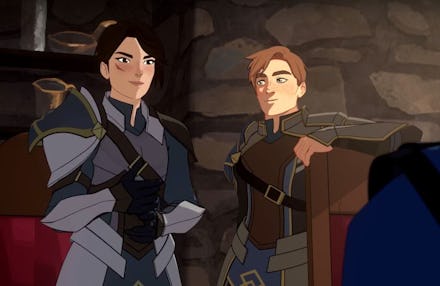Netflix’s ‘Dragon Prince’ is like an animated ‘Game of Thrones’ — only way more inclusive

You wouldn’t be wrong if you called Netflix’s The Dragon Prince a family-friendly version of Game of Thrones. Dragons, magic and medieval intrigue — they’re all here, in animated form.
The series focuses on an ongoing war between humans and elves, and follows three kids who stumble upon an item that could end the quarrel between both races. In just one nine-episode season, Dragon Prince manages to be a highly diverse depiction of the fantasy genre. Dragon Prince’s royalty, King Harrow, is dark-skinned with dreadlocks. His sons, Ezran and Callum, are different races (one is black, the other white).
But Dragon Prince’s most interesting character might be the king’s faithful lieutenant and sister-in-law, General Amaya, a woman who is deaf. Deaf characters are rarely rewarded with main-character status on television — fantasy or not — but Dragon Prince is the exception. When Amaya isn’t trading blows in her own fight scenes, she’s arguing in heated debates with the show’s antagonists.
According to Dragon Prince co-creators Aaron Ehasz and Justin Richmond, Amaya’s deafness was a deliberate choice on their part. “Her deafness is integrated into her skillset as a general,” Ehasz said in a phone interview. “The senses she was born with have shaped who she is. At any given moment in a battle, when everyone else is distracted by the noise and chaos of the fight, Amaya is focused and in the zone.”
Fans of Avatar: The Last Airbender, a show Ehasz worked on for three years, might be reminded of the character Toph, who was blind. “Toph was Michael DiMartino and Bryan Konietzko’s idea, originally,” Ehasz said. “Instead of making Toph a big, male character, we wanted to make her a small, female character whose presence was huge.” Toph’s lack of sight allowed her to approach battles in ways other characters wouldn’t. These traits live on in Dragon Prince’s Amaya.
“Creating Amaya was a huge challenge, but worth it to get the details right.”
There’s a reason animated shows aren’t teeming with characters who use sign language. Realizing General Amaya in Dragon Prince wasn’t easy for the team.
“As we brought Amaya to life, it was critical to us that she felt authentic,” Ehasz said. “We had a lot of conversations with people we knew who were deaf or hard of hearing, with interpreters and with organizations that support the deaf community. We encouraged the writers to dive into all of this and understand as much as they could. It was a huge challenge, but worth it to get those details right.”
The next challenge was execution. “On the production side, the biggest task was making sure everything was accurate,” Justin Richmond, Dragon Prince’s other co-creator, said over the phone. Amaya speaks using American Sign Language, or ASL, meaning the animators were tasked with properly depicting the intricacies of sign language in a cartoon.
“We used two different people ... to sign what we wanted Amaya to say, making sure it was all correct,” Richmond said. “We had all of the animators look at [the] reference video to properly animate the character’s speech.”
“Our writers’ room is a pretty diverse group. The only real pushback is about what jokes are funny.”
The team did their homework in an attempt to properly depict Amaya, but there’s one area where the creators admit they sacrificed authenticity for smoother storytelling — whether Amaya would be able to read lips, Ehasz said. Viewers learn that this is how she “listens” to other characters when Amaya tells the elf character Rayla to look at her when she’s talking to her.
“We knew how uncommon it is in the deaf community to be able to read lips well,” Ehasz said. “We imagined this as something Amaya developed over the years: She didn’t want anyone to ever get anything by her, so this is something she’d put time into.”
The Dragon Prince is filled with varying skin tones, accents and people of differing abilities. In most writers’ rooms, including non-traditional characters in these roles would take some convincing. But according to the creators, the entire room was always onboard. “There’s never been any pushback,” Richmond said. “Our writers’ room is a pretty diverse group. The only real pushback is about what jokes are funny.”
The team isn’t driven by agenda, though. In some cases, diversity is used for storytelling purposes. “We wanted the king’s sons’ differing races to instantly clue viewers into the fact that they’re step-brothers,” Ehasz said. In other cases, the team is driven by wanting to appeal to more types of people. “In the case of both Amaya and Toph, it comes from a place of wanting to reach a diverse audience,” Ehasz said.
“We generally aren’t really thinking, ‘What’s the next checkbox?’” Richmond said. “We focus on making characters that act as cool additions to the world that, hopefully, end up being more inclusive than what we had before.”